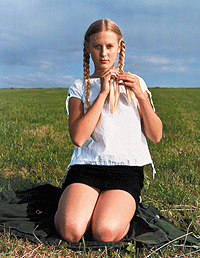Since the fall of the Berlin Wall in November 1989, Germany has re-emerged as a potent intellectual and creative center within the international art world.
From Feb. 9-April 29, the Kemper Art Museum presents “Reality Bites: Making Avant-garde Art in Post-wall Germany,” the first thematic museum exhibition to examine how contemporary artists have dealt with the social, economic and political ramifications of German unification.

“Reality Bites“ was conceived and organized by Sabine Eckmann, Ph.D., museum director and chief curator. It is the first major loan show in the museum’s new facilities, which were dedicated in October.
In all, “Reality Bites“ will feature approximately 70 artworks created since 1989, by both German artists and international figures living in Germany.
The vast majority of the artworks have never been exhibited in the United States. They range from video and photography to sculpture, installation, assemblage and new media art.
Artists consist of Franz Ackermann; Kutlug Ataman; Cosima von Bonin; Sophie Calle; Tacita Dean; Thomas Demand; Bernhard Garbert; Isa Genzken; Beate Gütschow; Rudolf Herz; Sabine Hornig; Christian Jankowski; André Korpys and Markus Löffler; Ulrike Kuschel; Eva Leitolf; Via Lewandowsky; Michel Majerus; Mariele Neudecker; Olaf Nicolai; Marcel Odenbach; Manfred Pernice; Daniel Pflumm; rude_architecture (Gesa Glück, Tobias Neumann and Friedrich von Borries); Silke Schatz; Gregor Schneider; Collier Schorr; Renata Stih and Frieder Schnock; and Wolfgang Tillmans.
One effect of German unification has been a new emphasis on experiential reality. In contrast to the abstract, simulated aspects of post-modernity, the historical realities of post-wall Germany continue to influence the daily experiences of its citizenry.
Artists have reflected this in a number of ways: by employing pop-culture imagery and integrating the viewer into the creation of aesthetic experience, by creating visual spaces that compete with social environments and by mimicking the rhetoric of globalization through the use of mapping and networking tools.
Such strategies highlight the dissolution of established artistic forms while blurring the distinctions between art and everyday life.
“Reality Bites,” which Eckmann began organizing in 2003, consists of three thematic sections: “Re-dressing Germany,” “Traumatic Histories” and “Global Spaces.”
“Re-dressing Germany” examines a variety of new and often-conflicting national self-images in the areas of politics, economics and culture. Artworks by Majerus, Kuschel, Odenbach and Genzken challenge the official symbolism of post-wall Berlin by embracing its physical reality.
Odenbach’s video installation “Niemand ist mehr dort, wo er hinwollte” (No One Is Where They Intended to Go) (1989-1990) recalls the moment of unification, while Jankowski’s video “Haus des Ostens“ (House of the East) (2000) investigates nostalgia for the German Democratic Republic, and Ataman’s installation “It’s a Vicious Circle“ (2002) explores the fragile nature of multiculturalism.
“Traumatic Histories” examines the painful legacy of events ranging from the Third Reich and the Holocaust to the oppressive East German regime and the terrorist Red Army Faction.
Yet in contrast to earlier avant-garde movements, the artists in “Reality Bites“ rely on neither expressionism nor the appropriation of Nazi aesthetics (as in the work of Anselm Kiefer or Hans Jürgen Syberberg).
Instead, they visualize narratives and create meaning through the use of fragmentary, mediated imagery.
Works include staged and manipulated photographs by Demand, Schorr and Herz; “Places of Remembrance”(1993), an installation by Stih and Schnock; and a mixed media piece by Korpys and Löffler that investigates a 1970s apartment used by the Red Army Faction.
The final section, “Global Spaces,” focuses on the concept of “transnationalism,” an idea that gained prominence as post-wall Germany responded to increasing globalization while attempting to address — or avoid — the fraught issue of national identity.
Artworks in this section emphasize ways in which the technologies of globalization have reconfigured alleged boundaries between local and national, public and private, near and far.
Hornig’s “Large Cube in Forest“ (2004) examines the role of architecture in the age of globalization, while Majerus and Pflumm survey the impact of mass culture.
Tillmans and rude_architecture propose the subway as a site for global encounters.
The exhibition will open with a reception from 7-10 p.m. Feb. 9.
In addition to the exhibit, a round-table discussion featuring artists Herz, Jankowski and Lewandowsky will be held at 4 p.m. Feb. 9 at the museum.
Both the discussion and the exhibition are free and open to the public. For more information, call 935-4523 or visit kemperartmuseum.wustl.edu.